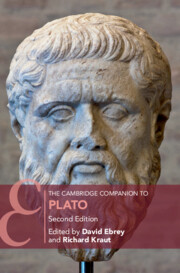Book contents
- The Cambridge Companion to Plato
- Other Volumes in the Series of Cambridge Companions
- The Cambridge Companion to Plato
- Copyright page
- Contents
- Contributors
- Acknowledgments
- Chronology
- Abbreviations
- 1 Introduction to the Study of Plato
- 2 Plato in his Context
- 3 Stylometry and Chronology
- 4 Plato’s Socrates and his Conception of Philosophy
- 5 Being Good at Being Bad: Plato’s Hippias Minor
- 6 Inquiry in the Meno
- 7 Why Erōs?
- 8 Plato on Philosophy and the Mysteries
- 9 The Unfolding Account of Forms in the Phaedo
- 10 The Defense of Justice in Plato’s Republic
- 11 Plato on Poetic Creativity: A Revision
- 12 Betwixt and Between: Plato and the Objects of Mathematics
- 13 Another Goodbye to the Third Man
- 14 Plato’s Sophist on False Statements
- 15 Cosmology and Human Nature in the Timaeus
- 16. The Fourfold Classification and Socrates’ Craft Analogy in the Philebus
- 17 Law in Plato’s Late Politics
- Bibliography
- Index Locorum
- General Index
- Other Volumes in the Series of Cambridge Companions (continued from page iii)
9 - The Unfolding Account of Forms in the Phaedo
Published online by Cambridge University Press: 21 July 2022
- The Cambridge Companion to Plato
- Other Volumes in the Series of Cambridge Companions
- The Cambridge Companion to Plato
- Copyright page
- Contents
- Contributors
- Acknowledgments
- Chronology
- Abbreviations
- 1 Introduction to the Study of Plato
- 2 Plato in his Context
- 3 Stylometry and Chronology
- 4 Plato’s Socrates and his Conception of Philosophy
- 5 Being Good at Being Bad: Plato’s Hippias Minor
- 6 Inquiry in the Meno
- 7 Why Erōs?
- 8 Plato on Philosophy and the Mysteries
- 9 The Unfolding Account of Forms in the Phaedo
- 10 The Defense of Justice in Plato’s Republic
- 11 Plato on Poetic Creativity: A Revision
- 12 Betwixt and Between: Plato and the Objects of Mathematics
- 13 Another Goodbye to the Third Man
- 14 Plato’s Sophist on False Statements
- 15 Cosmology and Human Nature in the Timaeus
- 16. The Fourfold Classification and Socrates’ Craft Analogy in the Philebus
- 17 Law in Plato’s Late Politics
- Bibliography
- Index Locorum
- General Index
- Other Volumes in the Series of Cambridge Companions (continued from page iii)
Summary
In Plato’s dialogues, Socrates calls things like justice, piety, and largeness “forms.” In several of these dialogues, he makes clear that forms are very different from familiar objects like tables and trees. Why, exactly, does he think that they differ and how are they supposed to do so? This chapter argues that in the Phaedo Socrates does not assume that they are different, but rather, over five stages of the dialogue, provides an account of how and why they do so. To fully understand the claims made in the first stage, one must look to the next stage, and so on until the final stage. Socrates' ultimate reason for distinguishing forms from ordinary objects does not depend on our intuitions about things like justice and largeness, nor on the distinction between universals and particulars. Ultimately, forms cannot be ordinary objects because the form of f-ness must cause every f-thing to be f, but no ordinary object could serve as such a cause. They cannot do so because they have multiple parts and are receptive of opposites; by contrast, the form of f-ness must be simple and unchanging, since it causes every f-thing to be f.
Keywords
- Type
- Chapter
- Information
- The Cambridge Companion to Plato , pp. 268 - 297Publisher: Cambridge University PressPrint publication year: 2022
- 1
- Cited by



